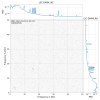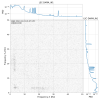Following up on the nonstationary noise (and DARM bicoherence) reported in 73662, which motivated the addition of a DARM boost/resG in 73740 (still in place, but hasn't reduced the nonstationarity).
I increased the EX ESD bias from it's normal value of +126V to +409V, and compensated with the gain in L3 L2L drivealign, the settings I used resulted in a DARM gain 1.2% lower than the nominal. In the first test, there were many glitches during the high bias time, we repeated the test a second time and didn't see glitches the second time. A comparison of spectra at these times doesn't show much difference other than the normal breathing of the low frequency DARM spectra. An inital look at spectragrams also doesn't show anything obvious.
quiet times:
- 20:06-20:27 UTC Nov 1st +409 V (loud glitches)
- 21:33:00 to 21:56:00 UTC Nov 1st +409 V (not glitches)
- 21:57:00 to 22:17:00 UTC +126 V
commands I used:
ezca['SUS-ETMX_L3_DRIVEALIGN_L2L_TRAMP'] = 60
ezca['SUS-ETMX_L3_LOCK_BIAS_TRAMP'] = 60
#go to positive half bias
ezca['SUS-ETMX_L3_DRIVEALIGN_L2L_GAIN'] = 74.982 #71.892
ezca['SUS-ETMX_L3_LOCK_BIAS_GAIN'] = 2
#go to positive full bias
ezca['SUS-ETMX_L3_DRIVEALIGN_L2L_GAIN'] = 48.6366 #47.22
ezca['SUS-ETMX_L3_LOCK_BIAS_GAIN'] = 2.85
#go to nominal settings (+126V bias) Nov 2023
ezca['SUS-ETMX_L3_DRIVEALIGN_L2L_GAIN'] = 184.65
ezca['SUS-ETMX_L3_LOCK_BIAS_GAIN'] = 1
Here's a first analysis of the effetc oof the ESD bias.
The attached PSD confirms that, in this particular time, a bias of 409V give better DARM below 30 Hz, but worse DARM above 30Hz, compared to a bias of 126V
To see if this is chance, one can look at a spectrogram. Even better, at a spectrogram whitened with the median spectrum of DARM when the bias is at 409V. Two observations:
- at 126V there is more non-stationary noise below 30 Hz
- at 126V, the noise between 30 and 80 Hz seems consistently a bit lower (subtle!)
So my conclusion would be that the worse spectrum above 30 Hz when the bias is 409V is real, but at the same time the non-stationarity is larger when the bias is at 126V.
One can look at the bicoherence of DARM with itself at 126V and at 409V. There is a striking difference: at 126V one sees the usual bicoherence of noise between 15 and 25 Hz with low frequency DARM, while at 409V this bicoherence is gone.
In conclusion, we should do a couple of repeated swithing tests to be sure, but for now: a bias of 409V seems to worsen slightly the noise above 30 Hz, but it reduces the non-stationary noise below 30 Hz.
The observation that the non-staationarity changes with the bias is interesting. It seems to indicate that the non-linearity that modulates high freqeuncy noise with low frequency motion is in the DARM actuation, namely in the ESD.
It is also consistent with the observation that tthe non-stationariity does not depend on the DARM low frequency gain, as shown by the boost experiment. This is because incrreasing the DARM low frequency gain changes the error signal, but the cntrol signal is almost exactly the same.
We should try to reduce the low frequency (<4 Hz) control signal to the ESD by reworking the DARM offloading to L2 and upper stages.






